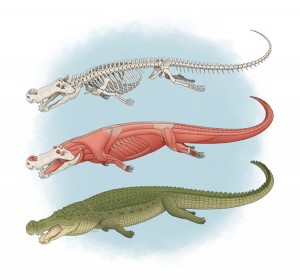Terror Croc Comes Out of the Shadows
Tuesday, September 15th, 2020

An artist’s recreation shows (top to bottom) the skeleton, muscles, and living appearance of Deinosuchus.
Credit: © Tyler Stone
Paleontologists (scientists who study prehistoric life) learned more about a terrible crocodile this summer. A study by Adam Cossette of the New York Institute of Technology and Chris Brochu of the University of Iowa examined newly discovered fossil remains of the extinct crocodilian Deinosuchus. Crocodilians are group of reptiles that includes crocodiles, alligators, gavials, and caimans. The scientists published a revised description of the animal in the Journal of Vertebrate Paleontology.
Deinosuchus lived from about 82 million to 75 million years ago, during the late Cretaceous Period. Its closest living relatives are alligators. In most ways, it looked much like a modern alligator, except that it was enormous. Deinosuchus grew to a length of 33 feet (10 meters) or more and weighed about 8,000 pounds (3,600 kilograms). In comparison, the largest crocodilian alive today, the saltwater crocodile, reaches lengths of about 23 feet (7 meters) and weighs 2,200 pounds (1,000 kilograms).
Deinosuchus also lived like modern crocodilians. During the late Cretaceous, much of central North America was covered by a shallow sea. Deinosuchus lived in the vast wetlands on the edges of this sea. Like large crocodilians today, Deinosuchus was an ambush predator. It would swim over to an animal at the water’s edge, lunge out of the water to grab it with its powerful jaws, drag its prey into the water, and drown it. What was on the menu? Just about anything—including dinosaurs.
Numerous fossils of contemporary dinosaurs show bite marks from an animal that could only have been Deinosuchus. It even attacked large, meat-eating theropods (dinosaurs like Tyrannosaurus Rex) on occasion. But for the most part, these predators stayed out of each other’s way, much as lions and Nile crocodiles do in modern Africa.
Deinosuchus was not identical to modern crocodilians, however. it had a greatly thickened skull relative to its size. The thickness likely strengthened it for struggle against dinosaurs and other large prey. Deinosuchus also had a bulbous (rounded) snout, with two small openings at its tip. Paleontologists do not yet know what purpose these features served.
Deinosuchus wasn’t the only giant crocodilian. Sarcosuchus, which lived about 110 million years ago, may have reached 40 feet (12 meters) long, about the length of a bus. Another titan was Purussasaurus, which attained similar proportions during the Miocene Epoch, long after the dinosaurs went extinct.
Discovering a new kind of prehistoric animal is great, but learning more about one that has already been discovered is great, too! Deinosuchus is not a recent discovery. In fact, it was first described in 1909. But many of the fossils were incomplete. With the new material, Cossette and Brochu were able to uncover more about the animal’s lifestyle and better differentiate between the small handful of Deinosuchus species. In doing so, they paint a more complete picture of what the world was like tens of millions of years ago—and what a terrifying place it was!


